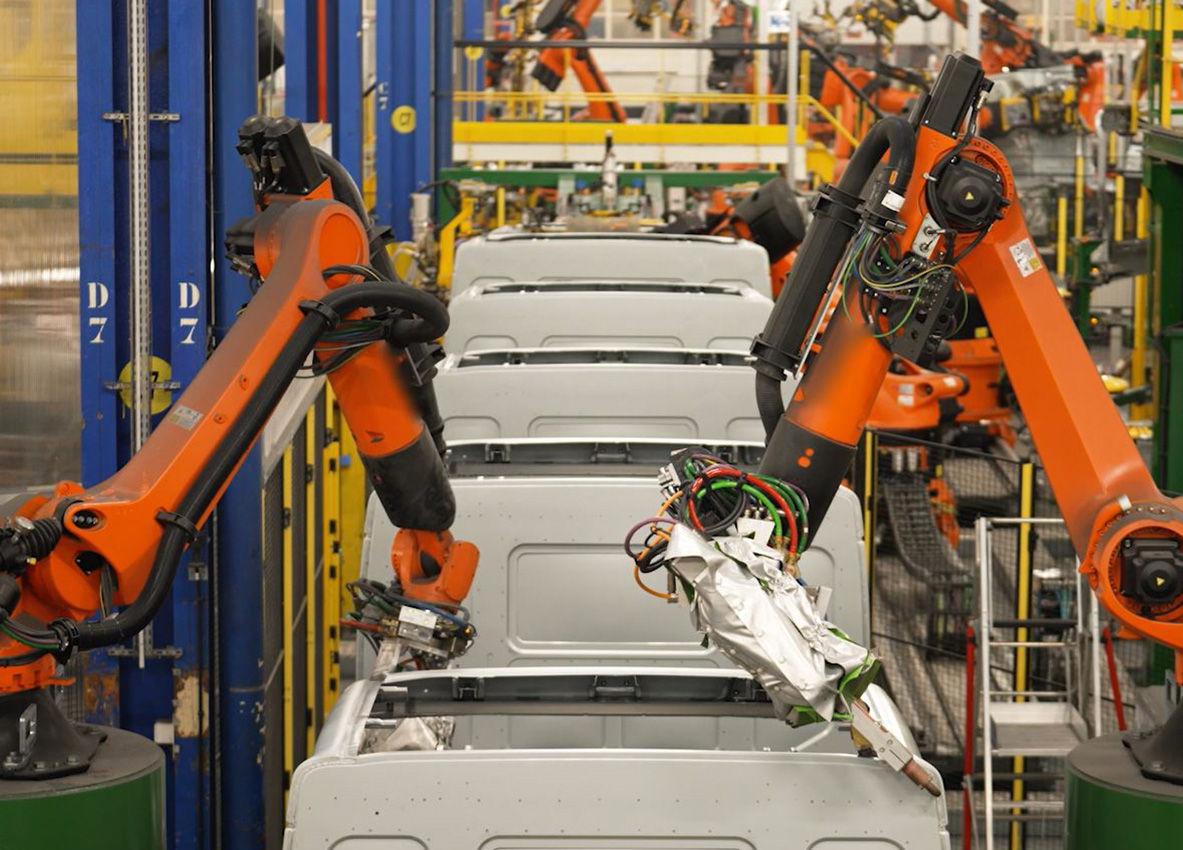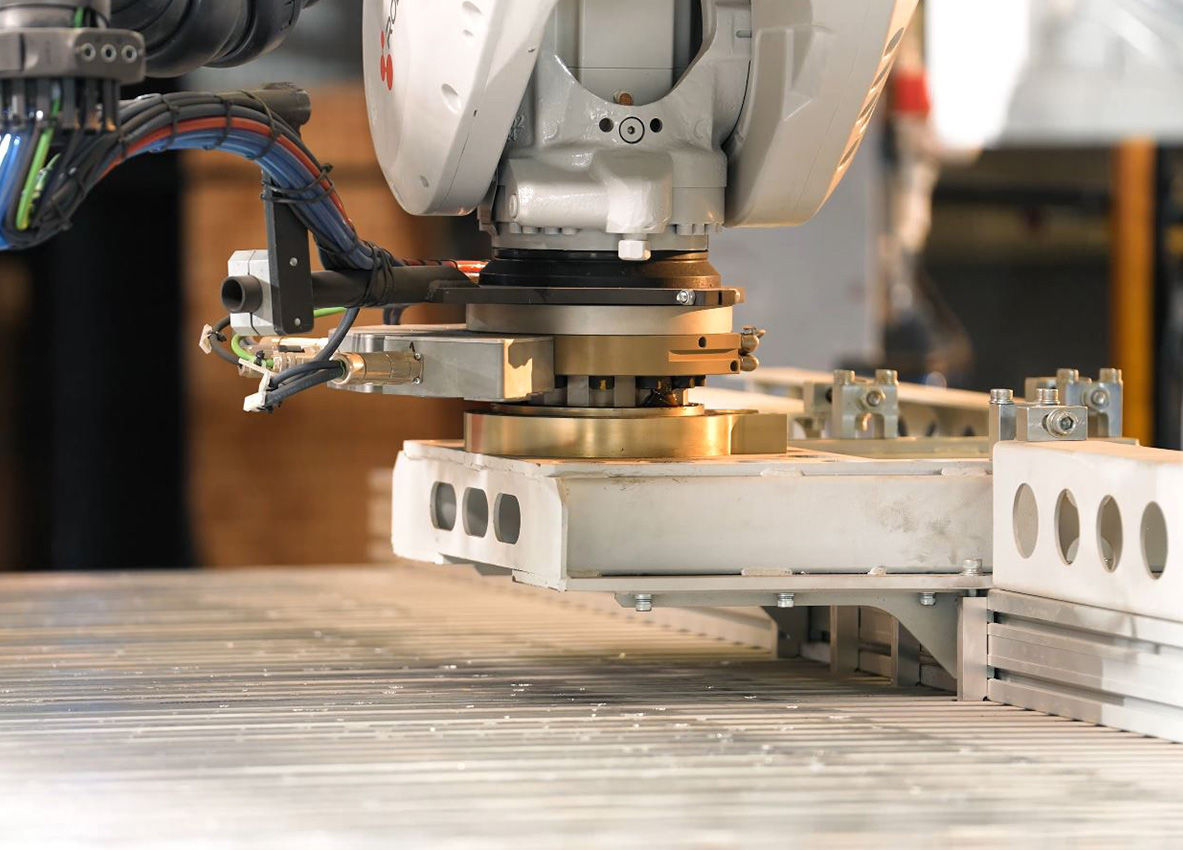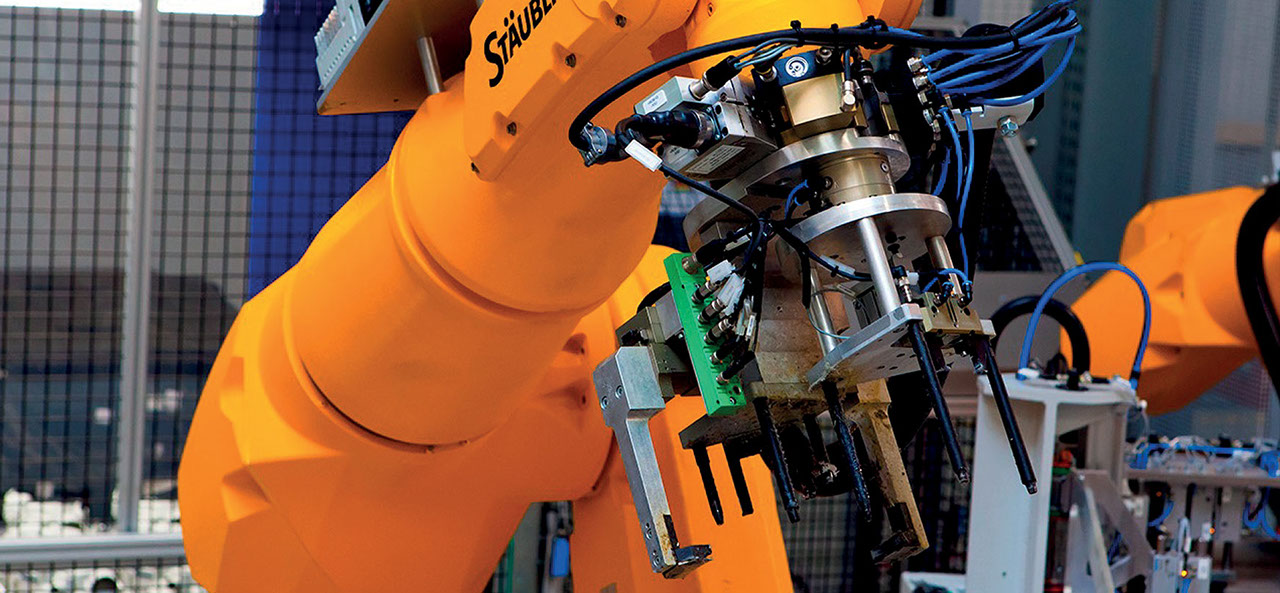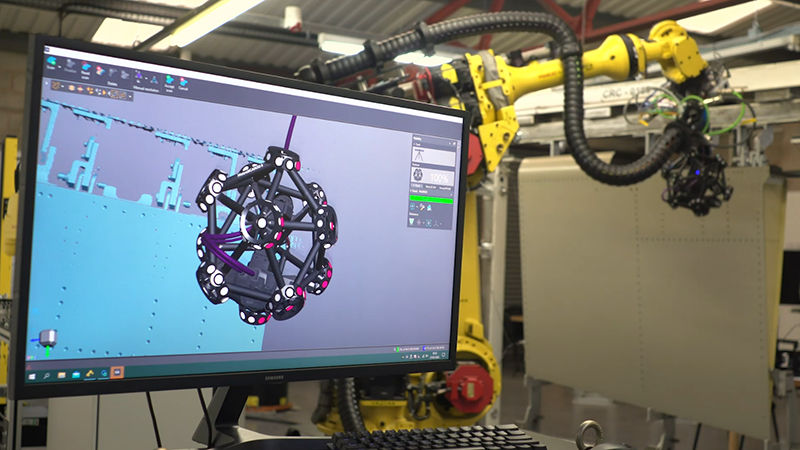Robotic tool changer for specific applications: From material handling to assembly and inspection
1. Primer
Robotic tool changers are one of the key elements of the modern, highly efficient manufacturing landscape. They enable fast, seamless tool change and are therefore essential in a wide range of automated manufacturing applications.
Robot tool changers, also known as tool changers, are the interface between the robot and the gripper or technology tool (end effector). Using a storage station, the tool changer system can equip the robot with the appropriate tools, such as welding guns, screwdrivers, milling cutters, drills, grippers, vacuum suction cups or even cameras and measuring systems, as required. This significantly increases the efficiency and productivity of tool changing compared to manual tool changing.
Tool changers are used throughout the industrial manufacturing value chain. Typical tasks include material handling, assembly and inspection, with tool changers playing a different role in each. Manufacturing companies benefit from an automated robotic tool changer system in terms of reduced downtime, increased throughput and reduced susceptibility to error.
When investing in robot tool changers, it is important for companies to carefully analyse their own application range and requirements. For standard manufacturing processes, there are ready-made application solutions on the market that cover a large proportion of standardised tool applications. Such solutions are particularly suitable for companies whose requirements are largely in line with industry standards. For special applications, however, it is important to find customised tool changer solutions for individual requirements. It is important to agree the interfaces to the robot hosepack and the connections to the technology tool with the customer in advance.
As a key catalyst for innovation and efficiency in manufacturing, the robotic tool changer enables sustainable increases in productivity and competitiveness. In this article, we take a closer look at the specific applications of robotic tool changers in material handling, assembly and inspection, analysing their benefits and presenting practical examples of their efficiency.
2. Applications in material handling
A. Definition of handling technology in robotics
Handling technology is one of the cornerstones and key applications of robotics - in simple terms, it describes all robot-assisted systems for gripping, transporting and moving objects (products, packaging, etc.). The use of robots in material handling is essential in industrial production technology. Robots are not only able to grip and move objects faster, more efficiently and more accurately, but unlike humans, they can also move particularly heavy, bulky or dangerous objects.
The tool changer plays a key role in this: it enables the robot to always have the right end effector at hand, by selecting suitable grippers or vacuum cups as required. Robot-guided handling technology can be found in virtually all manufacturing industries, with classic sectors including logistics and warehousing, the automotive industry, the food industry and electronics manufacturing.
B. The importance of efficient material handling in production
The production lines of modern industrial companies are increasingly focused on efficiency and productivity. Material handling plays a key role in this, as it represents the critical path in almost all manufacturing processes in terms of throughput time and therefore economic efficiency. The picking, moving and positioning of goods in production is a time factor that affects the entire value chain of the company.
As the backbone of an efficient manufacturing process, material handling must be designed to avoid bottlenecks in upstream and downstream processes. When automating material handling, it is therefore important to ensure that tool change systems are precisely tailored to the process requirements of the production line. By optimising typical pick-and-place applications such as transfer, sorting and palletising, it is possible to speed up production cycles and optimise the efficiency of mass production. At the same time, the need for skilled material handling personnel is reduced, resulting in a sustained reduction in labour costs.
C. Specific challenges for robot tool changers in material handling
The main challenge for robot tool changers in material handling is to optimise the technical and economic aspects of the individual requirements of the production process. Especially when handling products with different shapes and characteristics, it is important to equip the tool changer with all the necessary interfaces for the required end effectors.
As versatile as the range of handling end-effectors is, the tool changer must be just as flexible. Whether you need a suction cup for vacuum-assisted handling of packages, or a special food-grade soft gripper for picking up irregularly shaped fruit, the tool changer is perfectly compatible with both gripper systems.
When selecting a tool changer, the focus is always on future-proofing. One of the challenges is to take future requirements into account. Efficient material handling systems can respond flexibly to changes in production.
D. Advantages of using robotic tool changers in material handling
The benefits of modern robotic tool changers in material handling are many and include
- Increased productivity through fast and seamless part handling in the manufacturing process
- Significant cost savings through reduced labour costs and lower error rates
- Improved product quality through reduced error rates and gentle, part-specific handling
- Increased flexibility in the event of production line changes thanks to standardised tool interfaces
- Improved health and safety standards by automating ergonomically demanding tasks
E. Examples of material handling applications where robot tool changers show their strengths
Robot tool changers are at their best in a production process where different handling operations are carried out in the same place. The key is to minimise the time lost between two activities with different tools. Typical applications include:
- Picking up products or workpieces with grippers
- Rotating and aligning parts to a desired position
- Transporting from A to B
- Precise placement of parts in a specified position
- Sorting objects according to production specifications
- Palletising finished parts in preparation for despatch
When selecting a robot tool changer, it is always advisable to take a holistic view of the entire interaction between the changer and the application. Especially for small payloads, the combination of tool changer and gripping technology should be seen as a unit - the system is configured accordingly as a complete solution. Stäubli offers a wide range of high-precision end effectors that are optimally matched to the tool changers on offer.
3. Assembly and joining
A. Assembly and joining processes in production
Efficient and error-free assembly processes are one of the key success factors in modern industrial production. The assembly and joining of components and assemblies is typically characterised by a high degree of repetitive, time-consuming and labour-intensive operations, making it a natural candidate for automation. With ever shorter life cycles and development times, these operations are becoming a critical success factor.
The automation of assembly and joining operations is important in all industrial manufacturing sectors, but particularly in mass production in the electronics, automotive and plastics industries. The nature of assembly activities is very individual, with typical assembly line applications including
- Assembling components with small parts such as screws, rivets, gaskets, sleeves, etc.
- Precisely fitting components into existing assemblies
- Fitting plastic clips or plugs
- Assembly of gearboxes or engine blocks
- Bonding of components
Robotic systems are particularly beneficial for time-consuming and labour-intensive tasks requiring high precision.
B. The role of the robot tool changer
Assembly tasks are characterised by a large number of different activities in a single position. In many applications, several process steps need to be carried out in the same position by the same robot. In the automotive industry, for example, cylinder head assembly involves first inserting fitting sleeves and gaskets, which requires complex gripper geometry. In force-sensitive processes such as clipping, riveting or screwing, on the other hand, the process parameters must be accurately recorded by sensors and communicated to the control software.
Robot tool changers therefore have to meet a number of requirements for assembly tasks. In addition to the actual tool change, the tool changer must also have state-of-the-art transmission modules for media, power and data transfer.
C. Important considerations when selecting tool changers
When selecting tool changers for assembly and joining applications, the first step is to analyse the basic requirements of the process step to be automated. This primarily involves assigning suitable tools to the individual activities and specifying the necessary peripheral applications such as media, power and data transmission.
Relevant technical specifications for tool changers include, but are not limited to
- The permissible load capacity of the tool changer (kg)
- The achievable static torque (Nm)
- The dynamic torque (Nm)
- Allowable process parameters such as temperature (°C) and pressure (MPa)
- The IP degree of protection
- The repeatability (mm
- The number of module slots
- Interfaces to transfer modules for power and data transfer, pneumatics, RFID applications, grounding and other applications
In addition to the technical specifications mentioned here, quality parameters such as service life, wear, etc. must be taken into account from the user's point of view.
D. Benefits of using robotic tool changers
Robotic tool changers play a key role in increasing productivity, cost efficiency and quality standards in the complex assembly lines of industrial manufacturing. The benefits are many and include
Increased efficiency: Tool changers enable robotic assembly lines to change different end effectors quickly and seamlessly without the need for human intervention. This reduces production time and increases the efficiency of assembly tasks.
Flexibility: The ability to change tools quickly increases the flexibility of the assembly line. Even when requirements change due to new production demands or product variants, there is no need for manual retooling.
Cost reduction: Thanks to the significant increase in productivity, the investment in a robot tool changer typically pays for itself quickly. In addition to the pure increase in productivity, the positive effects on error rates and labour requirements must also be taken into account.
IV. Inspection applications
A. Importance of inspection processes in quality control
Industrial manufacturing companies use inspection processes to ensure that the manufactured products meet the desired quality standards. Inspection processes are usually integrated not only into the final quality control, but also as part of continuous quality monitoring along the entire production line. By continuously monitoring process and quality parameters across processes, it is possible to significantly reduce error rates and thus reduce waste and associated costs. At the same time, you can comply with regulations and standards and produce the necessary documentation.
Typical robot-assisted inspection tasks include checking component tolerances, surface quality, relevant process parameters such as temperature, pressure and flow rates, or functionality.
B. Integrating robot-assisted tool changers into inspection systems
Modern robotic tool changers can be seamlessly integrated into complex inspection systems. The ability to transmit signals and data is particularly important: data and signals from the inspection system can be transmitted in real time and made immediately available to the tools for process optimisation.
Tool changers are equipped with appropriate transmission modules that can transmit data and signals for integration into inspection systems. Typical applications include
- RFID modules with IO-Link interface for object detection
- Signal and data modules for Gigabit Ethernet applications (e.g. docked camera systems)
- Transmission modules for ultrasonic applications, e.g. for non-destructive testing of components
- Transmission modules for image and video signal processing
C. Specific requirements for tool changers in inspection applications
When selecting a robot tool changer for inspection applications, the compatibility of the tool changer with the application must be considered. In this context, the interfaces provided for transmission modules for signal and data transmission are of particular importance, as these largely determine the range of applications.
"It is therefore important to first select the type of inspection process required. In industrial mass production, these typically include
- Dimensional checks (dimensions, tolerances, surfaces)
- Visual inspections (e.g. using automated vision systems)
- Functional inspection (e.g. through automated functional testing)
- Material testing (e.g. non-destructive ultrasonic testing)
- Leak testing (e.g. using hydraulic or pneumatic applications)
Based on the selected inspection processes and technical specifications, a robot tool changer can be selected to meet these requirements.
D. Benefits of using robotic tool changers in inspection applications
The use of robotic tool changers in inspection applications offers far-reaching advantages. These include above all
Ensuring product quality: automated inspection processes make it possible to ensure compliance with in-house and customer-specific quality standards.
Ensuring safety: Continuous testing of component functionality and safety standards guarantees the proper functioning of the component, which is particularly important in sectors such as the automotive and aerospace industries.
Cost efficiency: The early, automated identification of defects ensures that the reject rate is reduced and weaknesses in the production process are quickly recognised.
Compliance with standards: Continuous monitoring of prescribed parameters ensures that legal requirements and technical standards are always met.
V. Conclusion
Robotic tool changers have become an integral part of the automation of industrial manufacturing processes. As the interface between the robot and the end effector, they are central to the efficiency and variability of the entire robotic system.
When selecting a suitable robot tool changer for handling, assembly and test processes, it is important to consider your own requirements and technical specifications. It is also advisable to consider future requirements due to product variations or possible changes in the manufacturing process. The choice of a suitable tool changer has a decisive influence on the production efficiency and quality of the entire production line. In addition to functionality, expected tool life and wear resistance are key considerations.
As a global supplier of mechatronic solutions, Stäubli offers state-of-the-art robot tool changers for a wide range of handling, assembly and testing processes. The MPS robotic tool changer offers a modular product concept that can be adapted to a wide range of customer requirements. Learn more about the proven and highly productive MPS robot tool changer systems.
More topics in focus
Our topics serve as your comprehensive resource for understanding the critical role of robot tool changers in enhancing efficiency across a multitude of applications.
Discover our innovative solutions - Download exclusive brochures now!
Stäubli is a leading technological pioneer in the construction and development of robotic tool-changing systems solutions.
Discover the versatility and efficiency of Stäubli's advanced robotic tool-changing systems by downloading our showcases of innovative solutions.
Success Stories
Find out our solutions and customer testimonials!
-

Silberhorn - Industrial Machinery
Component cleaning for metalworking in the tightest of spaces - Robot tool change in the wet cell. -

Volvo Trucks - Automotive
Provide robot tool change systems which meet Volvo’s demanding reliability target. -

Robinova / Teksan - Industrial Machinery
A field proven solution which saves time, improves robot utilization, and enhances operator safety. -

Miele - Industry Machine & Equipments
Miele opted for the modularity and efficiency of the MPS 130 systems with the Stäubli robots to develop their dishwasher lines production. -

TPR - Aerospace
True Position Robotics (TPR) provides smart solutions for robot drilling and inspection, designed to fit within a digital landscape.